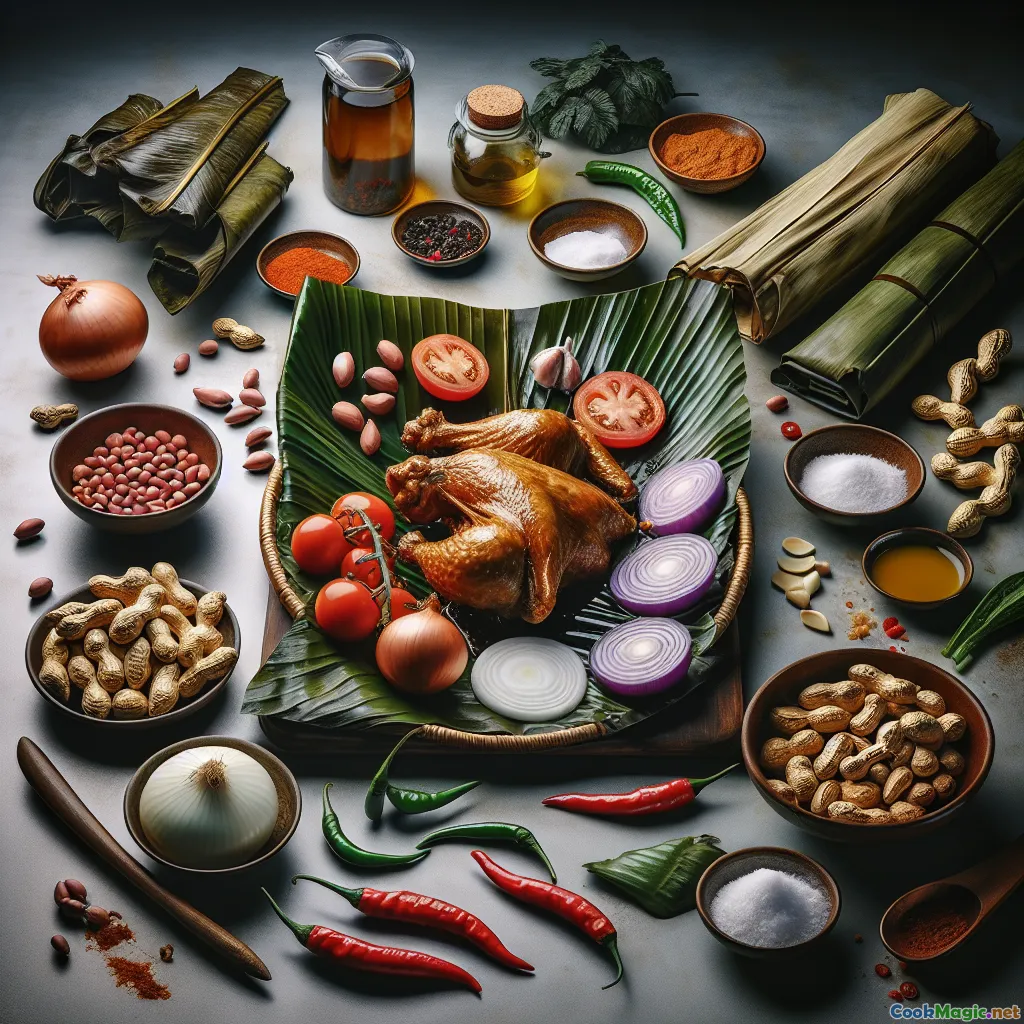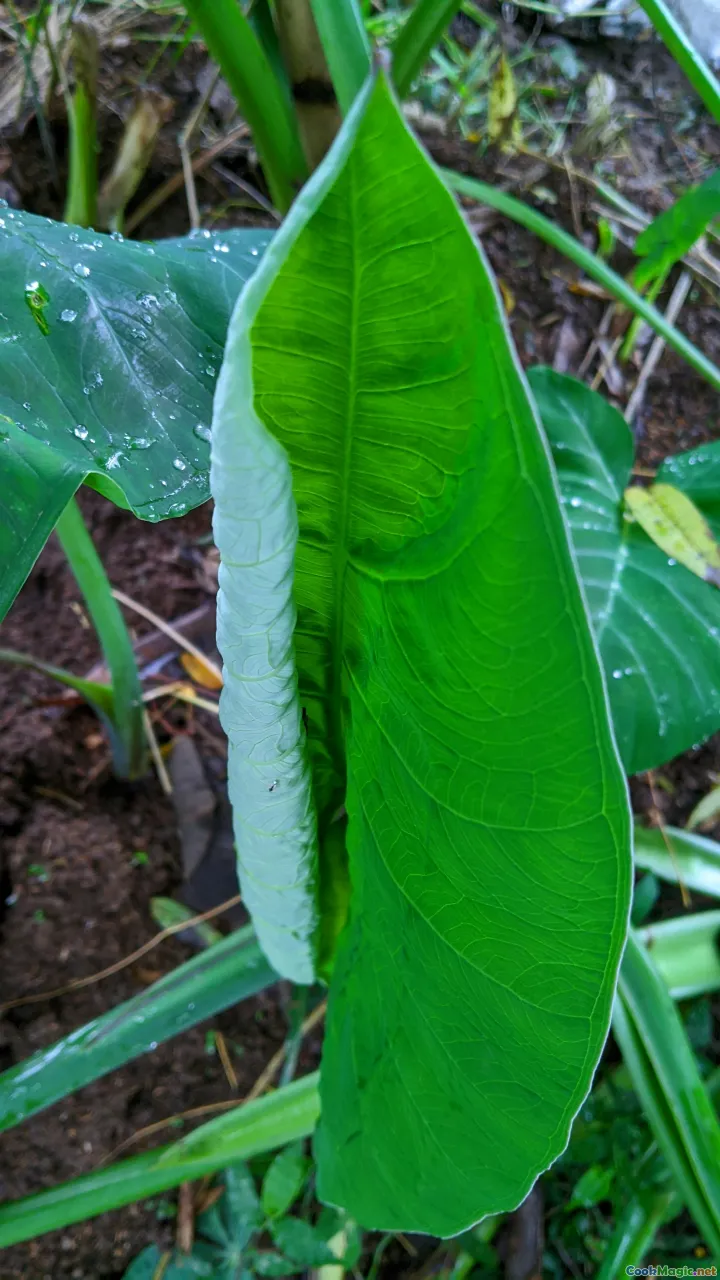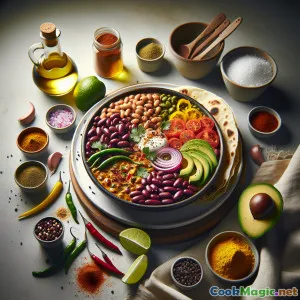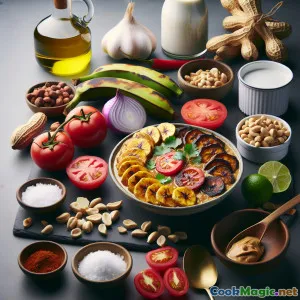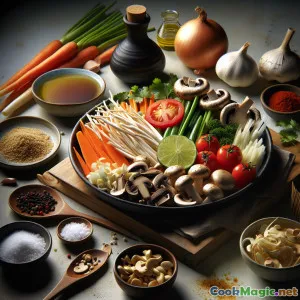
Exotic Luwombo Banana Leaf Parcels Delight
(0 Reviews)Ingredients
-
4 large leaves Banana leaves
(Cleaned and softened over fire)
-
800 grams Chicken thighs
(Boneless, skin on, cut into pieces)
-
2 medium Onions
(Chopped)
-
3 medium Tomatoes
(Chopped fresh)
-
100 grams Peanuts
(Roasted and ground into peanut butter)
-
4 tablespoons Palm oil
(Traditional cooking oil imparting deep flavor)
-
3 pieces Garlic cloves
(Minced)
-
1 inch piece Ginger
(Grated)
-
1 piece Hot chili pepper
(finely chopped, adjust to taste)
-
1 teaspoon Salt
(To taste)
-
1/2 teaspoon Black pepper
(Freshly ground)
-
100 ml Water
(For thinning stew if needed)
(Cleaned and softened over fire)
(Boneless, skin on, cut into pieces)
(Chopped)
(Chopped fresh)
(Roasted and ground into peanut butter)
(Traditional cooking oil imparting deep flavor)
(Minced)
(Grated)
(finely chopped, adjust to taste)
(To taste)
(Freshly ground)
(For thinning stew if needed)
Nutrition
- Servings: 4
- Serving Size: 1 parcel (approx. 300g)
- Calories: 480 kcal
- Carbohydrates: 18 g
- Protein: 40 g
- Fat: 30 g
- Fiber: 6 g
- Sugar: 5 g
- Sodium: 550 mg
- Cholesterol: 110 mg
- Calcium: 60 mg
- Iron: 4 mg
Instructions
-
1 - Prepare Banana Leaves:
Gently heat banana leaves over open flame or hot water to soften for easy folding without tearing. Set aside on a clean surface.
-
2 - Make Peanut Butter Sauce:
In a dry skillet, lightly toast whole peanuts until fragrant. Allow to cool, then grind into a fine peanut butter. Mix ground peanuts with palm oil, garlic, ginger, chili pepper, salt, and black pepper to form a thick rich sauce.
-
3 - Marinate Chicken:
Combine chicken pieces with chopped onions, tomatoes, and the peanut butter sauce. Mix thoroughly and let marinate for 20 minutes to absorb flavors.
-
4 - Assemble Parcels:
Spoon equal portions of the marinated chicken mixture onto the softened banana leaves. Fold the leaf to create a sealed parcel, tying if needed with strips of banana leaf or kitchen string.
-
5 - Steam Parcels:
Place parcels in a steaming basket over boiling water. Cover and steam gently for about 90 minutes until chicken is tender and infused with smoky, nutty flavors.
-
6 - Serve:
Carefully unwrap each parcel and serve the flavorful chicken with a side of boiled plantains or rice for a hearty meal.
Gently heat banana leaves over open flame or hot water to soften for easy folding without tearing. Set aside on a clean surface.
In a dry skillet, lightly toast whole peanuts until fragrant. Allow to cool, then grind into a fine peanut butter. Mix ground peanuts with palm oil, garlic, ginger, chili pepper, salt, and black pepper to form a thick rich sauce.
Combine chicken pieces with chopped onions, tomatoes, and the peanut butter sauce. Mix thoroughly and let marinate for 20 minutes to absorb flavors.
Spoon equal portions of the marinated chicken mixture onto the softened banana leaves. Fold the leaf to create a sealed parcel, tying if needed with strips of banana leaf or kitchen string.
Place parcels in a steaming basket over boiling water. Cover and steam gently for about 90 minutes until chicken is tender and infused with smoky, nutty flavors.
Carefully unwrap each parcel and serve the flavorful chicken with a side of boiled plantains or rice for a hearty meal.
More About: Exotic Luwombo Banana Leaf Parcels Delight
Luwombo Banana Leaf Parcels: A Cultural and Culinary Exploration
Summary: Luwombo is a traditional Ugandan dish that represents the rich culinary heritage of the Luganda people. This flavorful recipe uses banana leaves to steam a marinated blend of chicken, peanuts, and vegetables, capturing a unique balance of smoky, nutty, and spicy flavors. It is both a communal and celebratory dish often prepared during special occasions and festive gatherings.
Historical Context: The technique of cooking food wrapped in banana leaves has been practiced throughout various cultures in Africa, but particularly in Uganda, luwombo distinguishes itself by blending local ingredients like palm oil and ground peanuts, which form a luxurious sauce base. The banana leaves not only impart aroma but act as a natural steamer, preserving nutrients and moisture.
Cultural Significance: The process of preparing Luwombo is often social, with families coming together to prepare the parcels while sharing stories and traditions. The celebration surrounding the dish showcases hospitality and local flavors deeply rooted in green plantains, cassava, or rice side dishes.
Unique Aspects: What sets Luwombo apart is its use of ground peanuts combined with traditional herbs and palm oil, creating a dense sauce that penetrates the chicken during the slow steaming process. The banana leaf parcels seal in the flavors and exude an unmistakable earthiness.
Tips & Notes:
- Softening the banana leaves carefully prevents tearing and ensures neat wraps.
- Substitutes like collard or grape leaves can be used if banana leaves are unavailable, but the flavor profile will be different.
- Adjust the chili intensity according to your spice preferences.
- Toasting and grinding peanuts fresh is highly recommended for authentic taste.
- This dish requires ample steaming time; patience is key for tenderness and flavor melding.
Personal Thoughts: Luwombo Banana Leaf Parcels offer a culinary journey into Uganda's rich food traditions, marrying simplicity with deep flavor complexity. The balance of peanut richness, smokiness from steaming leaves, and aromatic spices make it not just a meal but an experience reflective of communal warmth and cultural pride. I recommend cultivating a slow cooking mindset with this recipe — the transformations happening inside those leaf parcels are nothing short of magic.
Enjoy executing this recipe with thoughtfulness, connecting to a time-honored African cooking tradition, and savor each bite packed with heritage!
